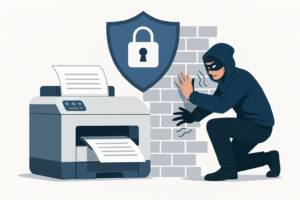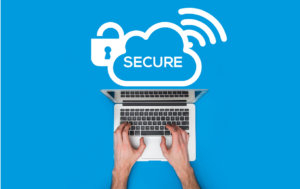Contactless Secure Printing – Protect Corporate Data Against Misuse And Employees from Coronavirus
We looked into the question of what influence the current corona crisis is having on corporate printing. How is the pandemic changing views on existing printing technologies?
Companies are concerned about protecting their staff from possible infection in the office. In addition to regular cleaning (or even disinfection) of shared equipment, it should also be ensured that employees have to touch as few surfaces as possible where viruses could be present. The risk of a smear infection exists, for example, with PIN-based release printing. This danger can be eliminated with contactless secure printing.

Secure print release/pull printing protects sensitive documents
To protect documents output to shared printers, companies are increasingly using secure printing, also known as release printing or pull printing. This means that a document is only output to the printer when the employee who initiated the print job authenticates themselves at the printer. This prevents printouts left in the printer’s paper tray from falling into the wrong hands.
When printers spread diseases
Different pull-printing solutions use different authentication methods. One very popular method is by entering a PIN at the printer. But with the coronavirus or Sars-CoV-2 crisis, many companies are asking themselves how to protect their employees from infection. In this context, it’s also important to prevent printers from transmitting the virus from one employee on to many others.
Even though the new coronavirus is probably transmitted from person to person mainly by droplet infection, smear infection (also called indirect contact transmission) through contaminated surfaces can also lead to infection. Scientists are currently not yet in complete agreement as to how long the virus remains active on which surfaces. However, in addition to stainless steel, it seems to last particularly long on plastic. This means that the new coronavirus can also be transmitted via a printer’s PIN pad. If an employee enters their PIN after an infected person who is not showing symptoms and is unaware of their infection and then touches their face, an infection can already occur.
Given the corona pandemic, which pull-printing methods are more suitable than PIN-based release printing to protect print jobs and employees alike?
Protect everyone’s health: Contactless secure printing
Contactless authentication methods protect printouts at shared corporate printers. They also protect employees from viruses on printer PIN pads, which are among the most heavily shared surfaces in offices. The following pull-printing methods are particularly suitable for contactless secure printing. And both are supported by ThinPrint and/or ezeep:
Secure print authentication with Release Station and RFID cards
For user authentication via RFID cards, release stations are used at which employees identify themselves contact-free. ThinPrint’s Personal Printing Release Station is suitable for all printer models and can be connected to up to 4 contactless card readers. Using cards from different manufacturers, employees release their documents securely and touch-free at the printer.
Secure release printing with e-mail
ezeep’s Print Later pull-printing feature can be implemented easily and without additional hardware in organizations. The solution ensures that documents are only printed when employees can personally receive them at the printer. Users simply select Print Later as the print option. This moves the document to a secure print queue in the cloud for 24 hours. Employees are reminded by email that a document is waiting to be printed. Users can approve their print jobs directly from the Print Later email or browser-based from the ezeep release portal.
Print Later also enables Delegate Release Printing: In this case, an employee simply forwards the Print Later email containing the release link to a colleague, who can then trigger the print job at the printer without touching it.
Contactless printing can easily be used as a secure alternative to PIN-based printing in companies of all sizes. Our ThinPrint team will be happy to answer any of your questions and we hope you and your employees stay healthy!




